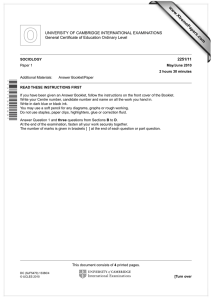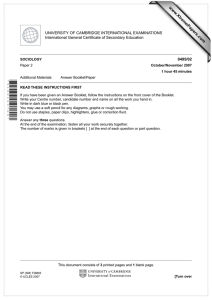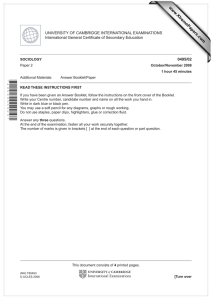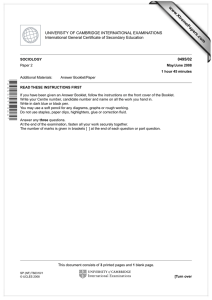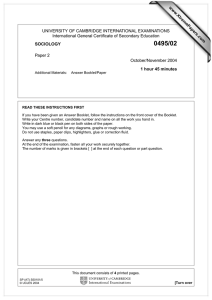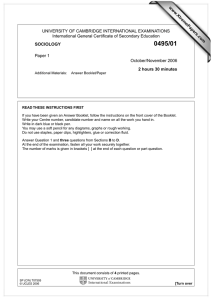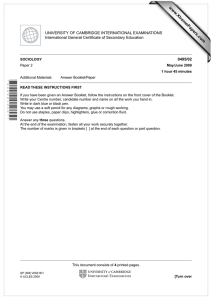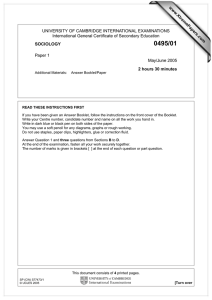www.XtremePapers.com
advertisement
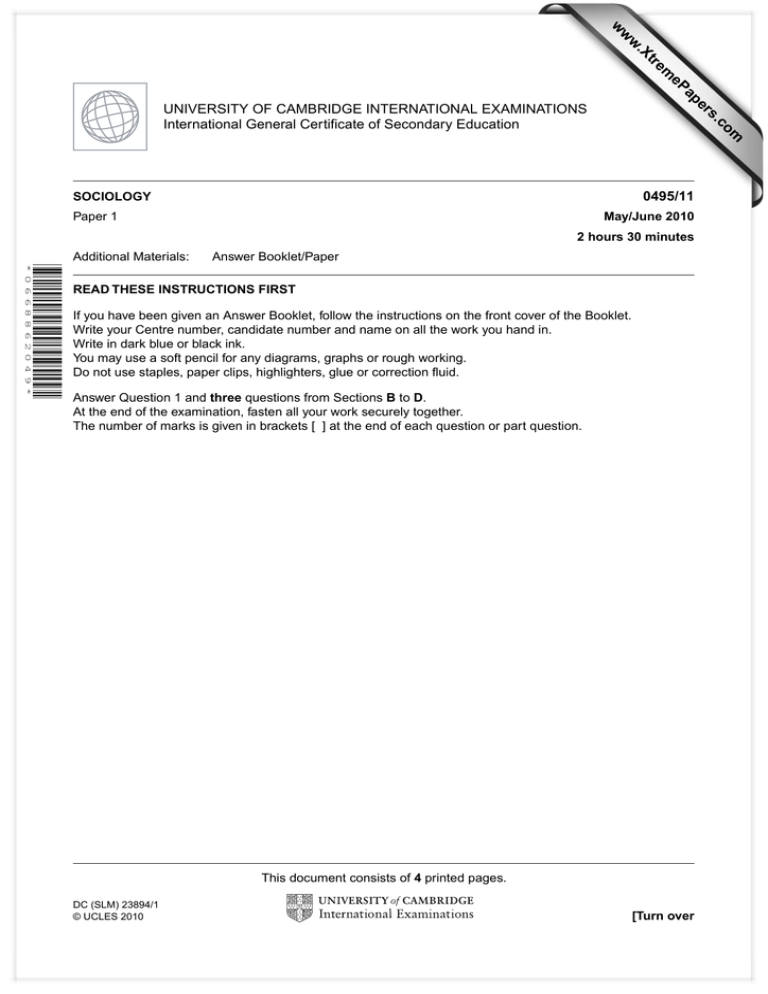
w w ap eP m e tr .X w om .c s er UNIVERSITY OF CAMBRIDGE INTERNATIONAL EXAMINATIONS International General Certificate of Secondary Education 0495/11 SOCIOLOGY Paper 1 May/June 2010 2 hours 30 minutes Additional Materials: Answer Booklet/Paper *0668862049* READ THESE INSTRUCTIONS FIRST If you have been given an Answer Booklet, follow the instructions on the front cover of the Booklet. Write your Centre number, candidate number and name on all the work you hand in. Write in dark blue or black ink. You may use a soft pencil for any diagrams, graphs or rough working. Do not use staples, paper clips, highlighters, glue or correction fluid. Answer Question 1 and three questions from Sections B to D. At the end of the examination, fasten all your work securely together. The number of marks is given in brackets [ ] at the end of each question or part question. This document consists of 4 printed pages. DC (SLM) 23894/1 © UCLES 2010 [Turn over 2 Section A: Research Methods The social survey is a method of research that involves collecting data from a large sample of people. This is usually gathered by the use of a questionnaire or structured interview. The data that is created is normally referred to as quantitative. Surveys tend to produce information which is less detailed than qualitative research, but they can be used to make generalisations over broad areas. Reliability is one of the strengths of surveys as the data collected can be easily coded and analysed and the process can be repeated by a different researcher in the same way. Surveys involving the collection of information at one point in time are referred to as cross sectional surveys. They provide evidence of what is happening in the present. Longitudinal studies are used to study people over time and are useful for analysing changes in a society. 1 (a) What is meant by the following terms: (i) questionnaire [2] (ii) qualitative research [2] (iii) data. [2] (b) Explain why data collected using social surveys ‘can be easily coded and analysed.’ [4] (c) Describe two types of sampling that may be used to collect data that is representative of a larger population. [4] (d) Describe one strength and one limitation of structured interviews. [4] (e) Describe one strength and one limitation of longitudinal studies. [4] (f) Describe two strengths and two limitations of using questionnaires in sociological research. [8] © UCLES 2010 0495/11/M/J/10 3 Section B: Culture and Socialisation 2 3 Sociologists believe individuals are socialised into society. Each society has its own distinctive cultural norms and values. (a) What is meant by the term norms? [2] (b) Describe two examples of cultural norms. [4] (c) Explain how a child may be socialised by their parents. [6] (d) To what extent are individuals shaped by socialisation, rather than instinct? [8] Social control is necessary to ensure individuals accept the norms and values of society. This is carried out by formal and informal controls. (a) What is meant by informal social control ? [2] (b) Describe two examples of formal social controls. [4] (c) Explain why there is a greater need for formal social controls in modern industrial societies. [6] (d) Some sociologists believe that the laws of society benefit all members of society equally. Assess this view. [8] Section C: Social Stratification and Inequality 4 5 Some people may migrate to another country to live in search of a better life. Often they form an ethnic minority in the new country and can only find low paid work. (a) What is meant by the term migrate? [2] (b) Describe two reasons why people might move to a different country. [4] (c) Explain why ethnic minorities may only be able to find low paid work. [6] (d) How far are ethnic minorities disadvantaged in societies? [8] Social class is a form of stratification found in many societies. This form of stratification allows some individuals to experience social mobility. (a) What is meant by the term social mobility ? [2] (b) Describe two forms of stratification other than social class. [4] (c) Explain how an individual can move from one social class to another. [6] (d) To what extent does social mobility exist in modern industrial societies? [8] © UCLES 2010 0495/11/M/J/10 [Turn over 4 Section D: Power and Authority 6 In democracies the government gains its authority from winning an election. (a) What is meant by the term authority ? [2] (b) Describe two features of a democracy. [4] (c) Explain how governments attempt to stay in power in a democracy. [6] (d) How far do governments in modern industrial societies represent the interests of all groups in society? [8] 7 Family background may have an important part in shaping an individual’s political views. However, in some modern industrial societies, political participation is declining. (a) What is meant by the term political participation? [2] (b) Describe two factors, apart from the family, that may influence an individual’s political views. [4] (c) Explain how news reporting may influence the way a person votes in national elections. [6] (d) How far is voting behaviour influenced by an individual’s social class and family background? [8] Permission to reproduce items where third-party owned material protected by copyright is included has been sought and cleared where possible. Every reasonable effort has been made by the publisher (UCLES) to trace copyright holders, but if any items requiring clearance have unwittingly been included, the publisher will be pleased to make amends at the earliest possible opportunity. University of Cambridge International Examinations is part of the Cambridge Assessment Group. Cambridge Assessment is the brand name of University of Cambridge Local Examinations Syndicate (UCLES), which is itself a department of the University of Cambridge. © UCLES 2010 0495/11/M/J/10
